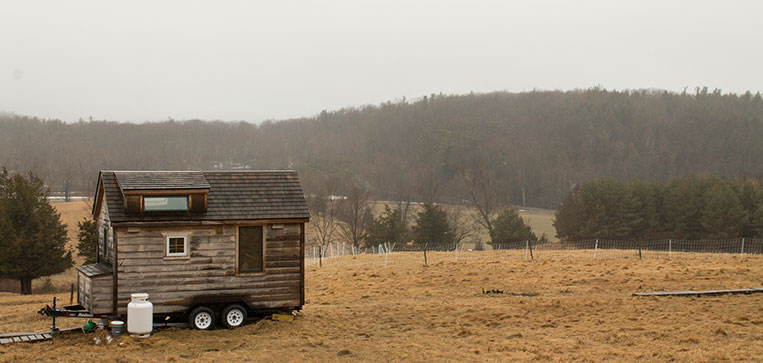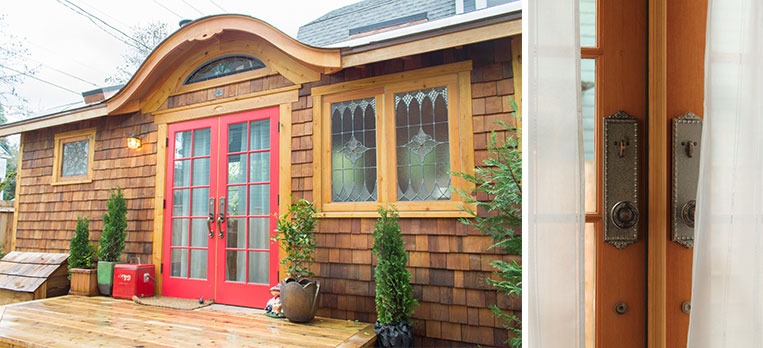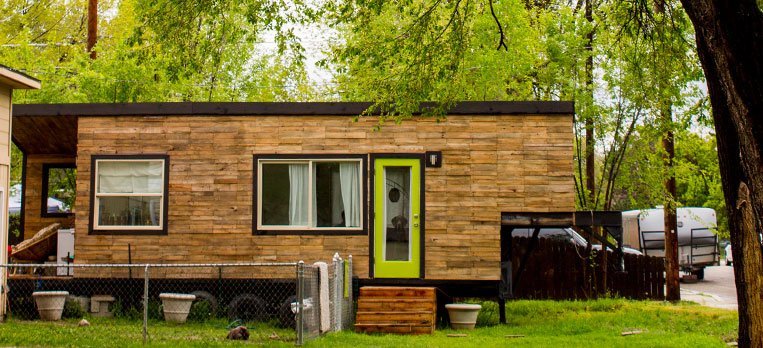
How do people who live in tiny homes handle parking and legality? To me, this was one of the most interesting things to discuss with the people I interviewed for my ebook, Life in a Tiny House. People who are interested in tiny homes often cite the parking and legality issue as their greatest barrier. Yet people who already live in tiny houses say their biggest challenges were things like roof rafter patterns So where’s the disconnect? Why is parking the central issue for some, and an afterthought for others?
This is going to sound a little “woo-woo,” but it really is all a matter of perspective. Is it risky, or not? Is the letter of the law something you follow, or interpret? Perspective alone doesn’t build houses, but it allows some people to move forward with their plans now, and keeps others waiting for changes in external circumstances like zoning and codes. The legal reality is the same for most people: tiny homes on wheels are usually just too new an idea to be considered fully legal housing. If someone doesn’t like where you’re parked and they complain to the right people, you might need to move. Once you know that, your perspective on the situation determines whether you still want to move forward. So how do the people who already call tiny houses home think about their parking?
Problems are Solvable
Most of the people I interviewed shared some variation on this theme about parking: “It will probably be fine, and if or when a problem comes up, I’ll just solve it.” That’s it. That’s the secret sauce. To some that might sound naive, but it’s also working, because they said it to me from the comfort of their tiny houses. It also wasn’t based on some kind of “head-in-the-sand” escapism. People had largely done their research, knew what they were getting into, and could also articulate a concrete experience that grounded their view that it would be okay. One example Aldo gave was camping: “I felt like something would work. I grew up camping. I knew that, if there’s not a camping site here, if you keep going down the road, they’ll be one somewhere.” He had prior experience of what it was like to have a Plan A fall through and discover that Plan B is okay too, so he decided he that the potential challenges of tiny home parking and moving didn’t outweigh his desire for how the house would support his life.
Macy had an interesting perspective on parking as well. She knew there were risks, but after experiencing a Kafka-esque, five-year mortgage foreclosure process in her conventional home, she felt that traditional housing wasn’t risk-free either. And if there were risks to both, she decided she’d prefer the situation she wanted to the situation that’s commonly accepted.
Life in the Fast Lane

Willingly placing yourself and your home in a legal gray area isn’t easy for everyone. But as I talk with people who have lived in tiny homes for years, and who are unconcerned with their legal status, I often think about speeding. Have you ever driven a car? If so, I’m willing to bet you’ve broken the law by speeding. So why does everybody ever feel comfortable going a few miles over the limit, but relatively few feel comfortable with the legal status of tiny homes? I’ve heard two primary rationales.
“If I get caught speeding, I just get a ticket. Moving a house is much harder.” True, if someone complains about your house, you might have to move. It would be a bummer. It would be work, and it could be stressful. But it’s also not the end of the world. Erin’s thoughtful comments about tiny house parking included the sentiment, “Moving a house is not heartbreaking. I’ve been through some heartbreak, everybody has, and it’s never something so silly as moving.” If the complications of moving concern you, think about Aldo and Erin’s perspectives. Try them on for a while. Think of times you’ve camped, or other situations where Plan B turned out just as good as Plan A – or maybe even better.
“Speeding isn’t a big deal – everybody does it.” I’ve written about the totally valid emotional reasons for feeling nervous to choose something rare or unfamiliar. But letting “everybody” determine your own course of action for something as major as your home may not be the right choice for you. Everyone’s mother was right, as it turns out: you shouldn’t jump off a bridge just because everyone else is doing it, and you don’t have to live in a conventional house just because everyone else is doing it, either.
The Options

But take heart – everyone isn’t living in a conventional house. The people in my book and the many other great people I’ve been introduced to while doing this project sure aren’t. A lot of people have their eyes wide open to the risks and the realities, and they feel a tiny home is ultimately going to help them live the life they want to live despite the gray areas.
If you’re dreaming of a tiny house but still feel stuck on the parking and legality issue, you really have two options:
You can wait until the external circumstances change, or work toward changing them. It’s quite possible that as the movement continues to grow, the laws and codes will be updated, and living in a home on wheels will become fully legal. But you’ll have to wait. And you’re not in charge of what happens, or when.
What you are fully in charge of is your perspective, so consider what that is. Consider the perspectives of others, especially those who already have what you think you want. Educate yourself about the specifics of your situation and your area. Then ask yourself what’s really at risk, if it’s worth it to you, and if you can solve whatever problems might arise. Because if you can adopt a perspective that allows you to move forward, you can start your dream today.

Comments are closed.